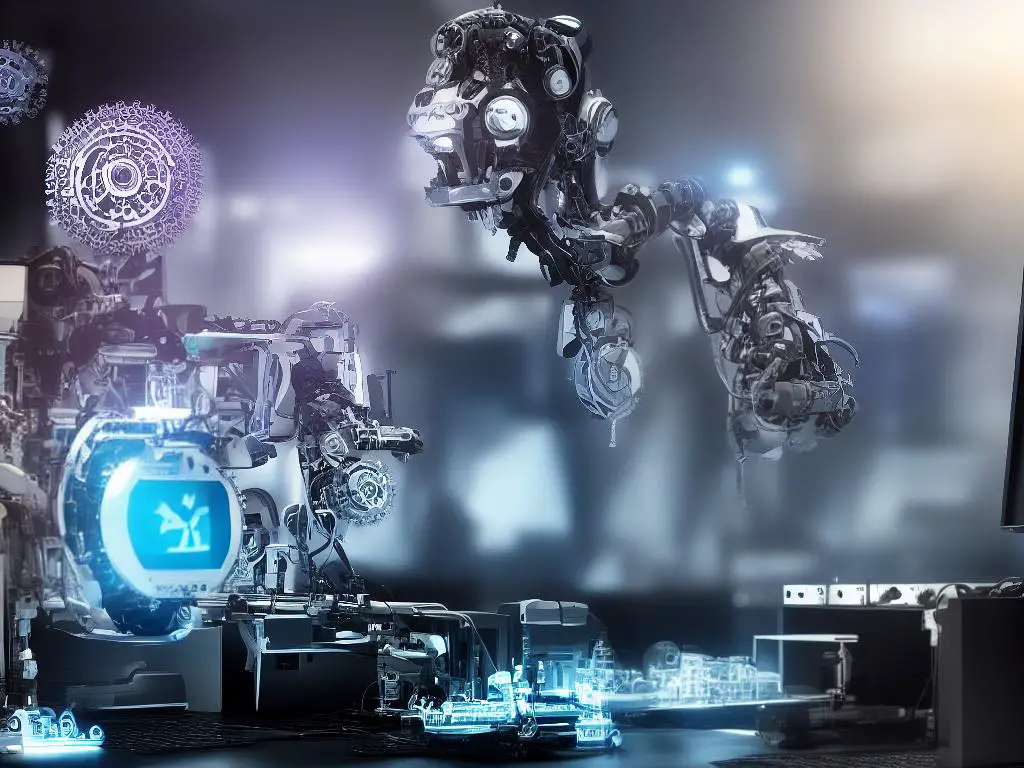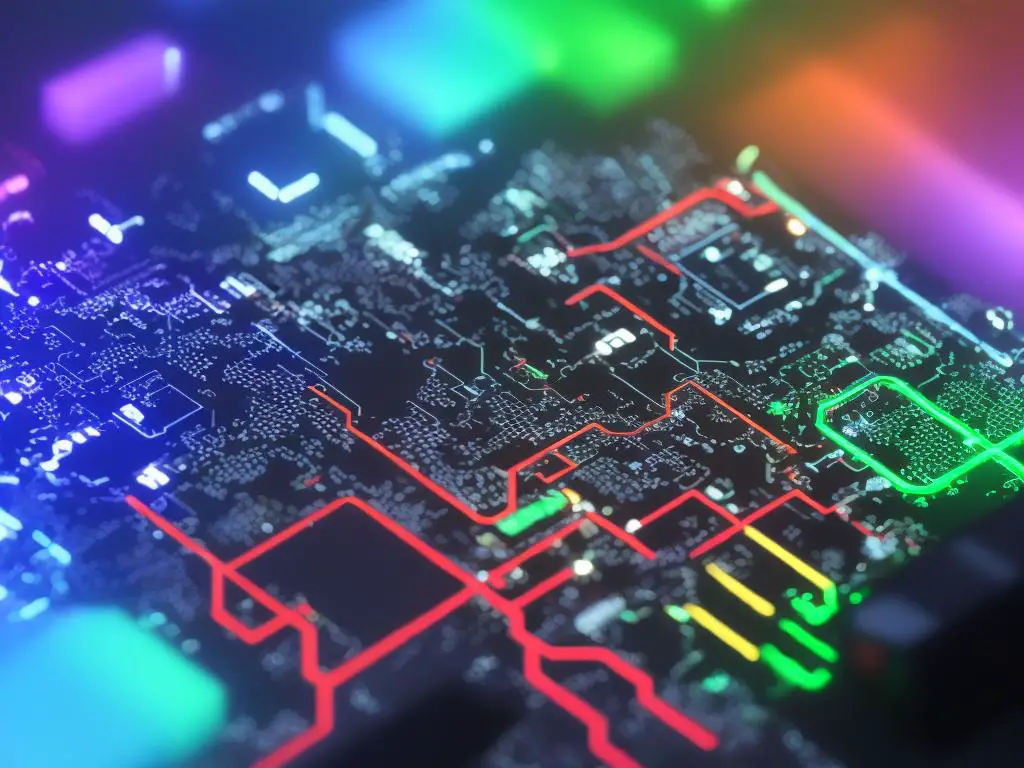Artificial intelligence (AI) has rapidly become a transformative force across numerous industries, influencing decision-making, driving innovation, and redefining the way we interact with technology. As AI models become increasingly sophisticated, there is a growing need to scale them in order to achieve higher levels of accuracy, performance, and capability.
In this context, understanding the vital role of scaling AI models and the challenges associated with it becomes crucial, as well as exploring the distributed training strategies and hardware advancements that can facilitate this endeavor. As we embark on this journey, it is important to keep in mind both the current landscape and potential future trends shaping the field of AI model scaling.
The necessity of scaling AI models
Table of Contents
- 1 The necessity of scaling AI models
- 2 Challenges in scaling AI models
- 3 Distributed training strategies
- 4 Hardware advancements & optimizations
- 4.0.1 Embracing Distributed Training Strategies and Tools for Efficient Scaling
- 4.0.2 Graphics Processing Units (GPUs) for AI Model Scaling
- 4.0.3 Tensor Processing Units (TPUs) for AI Model Scaling
- 4.0.4 Field-Programmable Gate Arrays (FPGAs) for AI Model Scaling
- 4.0.5 Hardware Optimization Techniques for AI Model Scaling
- 5 Future outlook & emerging trends
The rapid developments in artificial intelligence (AI) and machine learning (ML) have led to an increased demand for larger and more sophisticated AI models. These models are designed to handle a wide range of tasks, from powering voice assistants and chatbots to performing advanced analytics for businesses and medical research. As AI becomes even more integrated into our daily lives, the necessity of scaling AI models becomes ever more critical.
AI Models and Accuracy
One key reason for scaling AI models is to improve accuracy, as larger models have the potential to represent a more comprehensive understanding of a given task. As the amount and variety of training data increase, these models can capture more nuances and patterns that may be critical for high-performance applications. In turn, refined and more accurate models can be used to inform better decision-making in a wide range of fields, including finance, healthcare, and manufacturing, ultimately leading to improved efficiency and outcomes.
Modeling Performance and Capabilities
The performance of AI models is directly linked to their scalability. Larger models are generally able to process greater volumes of information, contributing to better overall performance. In recent years, researchers and engineers have been pushing the limits of AI by increasing the scale of models like OpenAI’s GPT-3 and various BERT-based models.
By doing so, they have unlocked AI capabilities previously thought to be unattainable. Whether it be natural language understanding, real-time decision making, or context-aware recommendations, scaling AI models makes all of these tasks more achievable.
Real-world Applications
There are many real-world applications in which the scaling of AI models is critical for success. For example, self-driving vehicles rely on sophisticated AI models to analyze and interpret vast amounts of data gathered from cameras, radar, and other sensors in real-time. The larger and more powerful the AI model, the better equipped it is to navigate complex driving scenarios and react to unexpected events, improving overall safety.
In healthcare, scalable AI models are being used to identify patterns and extract insights from massive amounts of medical data, including electronic health records, medical images, and biomedical research. These models can facilitate early diagnoses, more targeted treatments, and improved patient outcomes, all of which contribute to more effective healthcare systems.
Factors Driving the Need for Scalability
A variety of factors drive the demand for AI model scalability. The exponential growth of digital data, coupled with the need for real-time insights and decision-making, has made it increasingly important for AI models to be capable of handling the vast volumes of information they are required to process. Additionally, as industries become more globally interconnected, AI models must be able to adapt to and process information sourced from diverse linguistic and cultural contexts.
The rising expectation for AI models to be explainable and transparent further necessitates scaling capabilities. Increasing model size can help uncover previously obscured patterns and relationships, contributing to a more comprehensive understanding of how the AI system operates and makes decisions. This, in turn, enables better trust in AI applications and ensures they align with ethical guidelines and human values.
Challenges to Scaling AI Models
The potential benefits of scaling AI models are significant, but this growth also comes with a number of challenges, such as rising computational costs, data privacy concerns, and potential biases in training datasets. Nevertheless, by addressing these problems through innovation and forward-thinking approaches, the AI community can continue to expand the capabilities of large-scale AI models, ultimately leading to meaningful advancements across various industries.

Challenges in scaling AI models
Computational Limitations
The most prominent challenge in scaling AI models is managing the available computational resources. Training vast AI models usually demands significant processing capabilities to iteratively refine the model’s parameters using optimization algorithms like stochastic gradient descent.
Often, these computations need to be parallelized across multiple processors or distributed across numerous nodes to reduce training time and enable the exploration of more intricate models containing millions or even billions of parameters.
In particular, deep learning models that employ multiple layers of artificial neural networks to generate predictions are exceptionally resource-intensive. Training such models on substantial datasets with sophisticated architectures can quickly exhaust the capacity of even the most advanced processing units, including CPUs, GPUs, or specialized accelerators like TPUs. Given these requirements, companies must invest in powerful hardware solutions or dedicated cloud-based services to effectively scale AI models, presenting considerable financial and technical obstacles.
Memory Constraints
Beyond computational limitations, scaling AI models can also be hindered by memory constraints, as larger models and training datasets require more memory to store variables, intermediate calculations, and temporary values. For instance, when training deep learning models on high-resolution images or lengthy text, the memory costs may exceed the capacity of available hardware, leading to resource exhaustion, diminished performance, or even the inability to execute the desired scaling operations.
To overcome memory limitations, various strategies have been proposed, including model compression techniques, checkpointing, and memory-efficient training algorithms. However, each method comes with trade-offs, such as reduced model accuracy, increased training time, or a more complex development pipeline, which can complicate the scaling process and hinder the ultimate goals of the AI project.
Data Processing Bottlenecks
Processing vast amounts of data for AI model training can introduce substantial bottlenecks, which hinder the parallelization of tasks and impose additional limitations on scaling. As the number of training examples grows, so does the effort required to preprocess, augment, and transform the data into a digestible format for the model.
Moreover, feeding data into the model at a rate commensurate with its computational capabilities can also be challenging, as inefficient data loaders or I/O systems can often become the primary obstruction to further scaling.
Addressing data processing bottlenecks typically involves optimizing data flows across the system, utilizing advanced data pipelines, or applying data partitioning techniques. However, achieving efficient data processing can be a daunting and time-consuming task, ultimately impeding the desired scaling goals.
Architectural Complexities
Scaling AI models is often intricately tied to the underlying software and hardware architecture. Designing scalable architectures that can accommodate increasingly sophisticated models requires careful consideration of multiple components, such as parallelism, concurrency, communication, load balancing, and fault tolerance.
For distributed systems, these complexities are further magnified, necessitating the coordination and synchronization of multiple nodes while minimizing the latency and overhead introduced by communication and data transfer between them.
Mastering these architectural aspects can be a formidable challenge for even experienced developers and researchers, demanding expertise in a variety of domains and the constant refinement of best practices in the rapidly evolving landscape of AI technology.
Algorithmic Challenges
The variety of algorithms used in AI models presents another challenge for scaling. Some algorithms are inherently difficult to scale due to their computational and memory requirements, such as recurrent neural networks (RNNs) or highly interconnected graphs with complex propagation mechanisms.
In other cases, incremental updates or out-of-core processing may introduce complications in parallel or distributed settings. Additionally, ensuring consistency and convergence of the model’s parameters when scaling across multiple processors or nodes can pose further challenges, requiring sophisticated algorithms tailored to the particular model architecture or learning task.
Overcoming these obstacles often necessitates the development or adaptation of algorithms to better accommodate the specific requirements and constraints of the target hardware and dataset. This process can be labor-intensive and requires an in-depth understanding of both the algorithmic and implementation details, making it a pivotal challenge for successful AI model scaling.
Conclusion
As AI models expand in scale and complexity, various challenges emerge in scaling these models efficiently. Obstacles such as computational limitations, memory constraints, data processing bottlenecks, architectural complexities, and algorithmic challenges must be surmounted.
Overcoming these issues often necessitates extensive expertise, advanced hardware solutions, or specialized techniques. Consequently, scaling AI models is a formidable task for researchers, practitioners, and organizations in the field, and addressing these challenges is essential for the continued advancement of AI and its real-world applications.

Distributed training strategies
Distributed Training Strategies for Scaling AI Models
Given the magnitude of these challenges and the increasing importance of AI models and deep learning techniques in tackling complex tasks across various domains, it is crucial to consider innovative means to scale these large-scale models effectively.
Distributed training strategies are being employed to reduce the burden of massive computational resources and lengthy training times. This article explores the distributed training methodologies for scaling AI models, including data parallelism, model parallelism, and hybrid approaches. It also highlights relevant frameworks and tools, such as TensorFlow, PyTorch, and Horovod, that support distributed training.
Data Parallelism
Data parallelism is a distributed training strategy that involves dividing the input dataset into smaller batches and performing simultaneous parallel training on each batch. This approach leverages multiple GPUs or devices to process and train on these subsets individually and computes the gradients independently. Afterward, the gradients are averaged and applied to update the model. This iterative process continues until the model converges.
Data parallelism offers a natural way to scale AI models, especially when dealing with large amounts of data. The main advantage of data parallelism is its simplicity, as this method allows for easy implementation and works well when GPUs have sufficient memory. However, it may face communication bottlenecks when synchronizing large models or when the data transfer bandwidth is limited across devices.
Several frameworks support data parallelism. For example, TensorFlow and PyTorch provide built-in APIs for distributed data parallelism. Additionally, Horovod, an open-source distributed training library, can also be employed to perform data parallel training across multiple machines or GPUs.
Model Parallelism
Model parallelism is another distributed training strategy that involves partitioning the model itself across multiple devices. This approach typically suits enormous models whose total memory requirements exceed the available GPU memory. By splitting the model, each device computes only a segment of the model, and its corresponding subset of gradients, thereby enabling large models to fit within the memory constraints of available hardware.
Model parallelism effectively deals with memory limitations but can introduce significant communication overhead as partial results of the computation must be exchanged frequently among devices during forward and backward passes. It also presents a more complex implementation challenge compared to data parallelism. Some frameworks, like TensorFlow and PyTorch, offer built-in support for model parallelism; nevertheless, it often requires manual interventions and careful designing of the model partitioning schemes to optimize performance.
Hybrid Distributed Training Approaches
A hybrid approach combines elements of both data parallelism and model parallelism to address the challenges in training large-scale AI models. This approach is particularly well-suited for scenarios where a single model may not fit within the memory of a single device, and the input dataset is substantial. To implement this approach, the model is first partitioned across devices (model parallelism), and then the input dataset is divided into smaller batches that are processed in parallel (data parallelism).
Hybrid distributed training provides a more fine-grained control over the allocation of resources and can effectively address the memory and communication bottlenecks observed in pure data-parallel or model-parallel methods. While adopting a hybrid strategy can yield significant benefits in terms of training efficiency, it also requires a potentially complex setup and may demand more profound expertise in managing communication patterns and model partitioning schemes.
Several frameworks and tools facilitate distributed training using hybrid approaches, TensorFlow and PyTorch among them. Additionally, research projects like Megatron-LM and GPipe focus on promoting advancements in hybrid distributed training for scaling AI models.
Introduction to Hardware Advancements and Optimizations
Developing and scaling AI models require powerful computational capabilities to handle large volumes of data and complex algorithms. Over the years, there have been enormous advancements in hardware technologies that facilitate AI model scaling, such as Graphics Processing Units (GPUs), Tensor Processing Units (TPUs), and Field-Programmable Gate Arrays (FPGAs).
These hardware advancements support faster training and inference, enable larger models, and help developers build more complex AI applications. In this article, we will explore these hardware advancements and optimizations in-depth as they relate to scaling AI models.

Hardware advancements & optimizations
Embracing Distributed Training Strategies and Tools for Efficient Scaling
Effective scaling of AI models also demands the adoption of distributed training strategies that address the challenges associated with massive computation requirements, large input datasets, and memory limitations. Data parallelism, model parallelism, and hybrid approaches are popular methods to accomplish this.
Key frameworks and tools like TensorFlow, PyTorch, and Horovod enable practitioners to implement distributed training methodologies, taking full advantage of the advanced hardware capabilities. By combining the power of these hardware advancements and sophisticated distributed training strategies, AI researchers and developers can continue pushing the boundaries of AI research and development.
Graphics Processing Units (GPUs) for AI Model Scaling
GPUs have been a significant force behind the rise of AI and deep learning in recent years. These processors were initially designed for rendering complex graphics, but their highly parallel structure makes them an excellent choice for handling the matrix operations common in AI workloads. GPUs typically consist of thousands of small cores that work together in parallel to perform the required computations much faster than traditional CPUs.
NVIDIA, a pioneer in GPU technology, has developed AI-specific hardware, such as the Tesla, Quadro, and GeForce product lines, which are optimized to support deep learning frameworks like TensorFlow and PyTorch. The newer generation of GPUs, like the NVIDIA A100, have been designed for AI model scaling, offering massive performance improvements, higher memory bandwidth, and faster interconnects.
Tensor Processing Units (TPUs) for AI Model Scaling
Tensor Processing Units (TPUs) are custom-built application-specific integrated circuits (ASICs) designed by Google explicitly for AI and deep learning tasks. These processors are built to efficiently handle the tensor operations that power various machine learning models. TPUs are specifically designed to handle large-scale AI models, with improved efficiency and reduced power consumption compared to GPUs.
Google’s most recent TPU, the TPU v4, provides an impressive 260 teraflops of raw performance and supports massive AI model scaling with its high-bandwidth memory and interconnects. Google has also made TPUs available in their cloud infrastructure, allowing developers to leverage these powerful processors for training and deploying AI models at scale without the need for specialized hardware.
Field-Programmable Gate Arrays (FPGAs) for AI Model Scaling
Field-Programmable Gate Arrays (FPGAs) are a type of reprogrammable hardware that can be configured to perform specific tasks. In the case of AI and deep learning, FPGAs offer the advantage of configurability, enabling developers to build custom hardware accelerators tailored to their specific AI workloads. This dynamic adaptability results in high power efficiency and reduced latency for AI applications.
Microsoft has been leveraging FPGAs in its Project Brainwave to accelerate AI model deployments in its Azure cloud services. Intel is also developing its FPGA product lines, such as the Arria and Stratix series, which are optimized for AI and machine learning tasks. These FPGA-based solutions enable AI model scaling through custom implementation and power-efficient design features.
Hardware Optimization Techniques for AI Model Scaling
Alongside the hardware advancements, various optimization techniques have been developed to make the most of these powerful processors and ensure effective handling of large-scale AI models. Some important optimization considerations include:
- Resource Allocation: Efficiently utilizing available hardware resources, such as memory, compute units, and interconnects, is crucial to achieving optimal performance. Techniques like memory management, batching, and parallelism can help utilize these resources effectively.
- Load Balancing: Distributing the computational load across available hardware components is essential to maintain high throughput and prevent bottlenecks. This can be achieved through techniques like data parallelism and model parallelism.
- Power Efficiency: Reducing power consumption is a critical concern when deploying large-scale AI models. Hardware manufacturers are continuously optimizing their devices for lower power usage, while software frameworks are being designed to support power-saving techniques like sparsity, quantization, and pruning.
The landscape of AI and machine learning is growing exponentially, bolstered by rapid advancements in hardware technologies such as GPUs, TPUs, and FPGAs. These cutting-edge hardware developments have revolutionized AI model scaling by providing enhanced computational capabilities, quicker training periods, and energy-efficient solutions.
Additionally, hardware optimization techniques like resource allocation, load balancing, and power efficiency ensure that developers can effectively manage large-scale AI models, catering to the ever-increasing demand for more intricate and powerful AI applications.

Future outlook & emerging trends
Neuromorphic Computing
Building upon these hardware advancements, neuromorphic computing emerges as a highly promising approach for further scaling AI models. Neuromorphic computing aims to replicate the human brain’s structure and functionality, thereby refining computation abilities in AI systems.
This innovative approach involves creating specialized hardware which simulates neural networks more efficiently, resulting in reduced energy consumption, accelerated learning, and increased accuracy. As we continue to integrate these designs into AI applications, scaling complex models will become increasingly feasible and cost-effective, paving the way for even more advancements in artificial intelligence.
Advances in Software
Software development plays a crucial role in AI scaling. Researchers and developers continue to create innovative solutions to optimize AI algorithms, enabling more efficient and scalable development processes. Techniques like model pruning, quantization, and knowledge distillation enable a more significant reduction in model size while maintaining high levels of performance. By incorporating advanced hardware and software techniques, we can utilize the full potential of AI systems and scale them to solve more complex problems.
Research Breakthroughs
Research breakthroughs are continuously arising in the field of AI, leading to improved algorithms and novel methodologies. For example, advancements in Reinforcement Learning (RL) algorithms have resulted in groundbreaking capabilities for AI systems, such as learning from expert demonstrations or guiding policies with minimal data. Moreover, unsupervised and semi-supervised learning methods have also shown potential in enabling AI scaling by reducing the dependency on labeled data.
Zero-shot Learning
Zero-shot learning is another emerging trend in AI that could greatly impact model scaling. This technique allows AI models to recognize new instances without any prior exposure or training data, essentially learning in a “zero-shot” scenario. If successful, this approach could dramatically reduce the amount of training data needed for AI models, thereby reducing both the time and effort required to scale them. By learning general representations and leveraging additional knowledge source, zero-shot learning could contribute significantly to the future of AI scaling.
Federated Learning
Federated learning is a relatively new machine learning method that enables AI models to learn from decentralized data storage, such as devices in the Internet of Things (IoT) ecosystem. This approach allows AI systems to train and update their models using a distributed dataset, thereby reducing data centralization and privacy concerns. The ability to scale AI models efficiently with minimal data movement and lower computational requirements makes federated learning a promising area for future scaling of AI systems.
Summary
In summary, the future of scaling AI models holds numerous exciting possibilities. The exploration of neuromorphic computing, advances in software, research breakthroughs, zero-shot learning, and federated learning all have the potential to greatly impact how AI systems scale and the complexity of problems they can tackle. As technology evolves and new methodologies emerge, the future looks promising for the scalability of AI models, enabling them to solve increasingly complex real-world challenges.

Scaling AI models is undeniably a multifaceted endeavor that requires addressing a range of challenges, such as computational limitations, memory constraints, and algorithmic complexities. By leveraging distributed training strategies, advances in hardware technologies, and new research breakthroughs, it is possible to overcome these obstacles and realize the full potential of large-scale AI models.
As we look forward, emerging trends like neuromorphic computing, zero-shot learning, and federated learning promise to further transform the landscape of AI model scaling and open new avenues for innovation. Ultimately, embracing these developments and staying ahead of the curve will be essential for harnessing the power of AI to drive meaningful change across industries and society at large.

I’m Dave, a passionate advocate and follower of all things AI. I am captivated by the marvels of artificial intelligence and how it continues to revolutionize our world every single day.
My fascination extends across the entire AI spectrum, but I have a special place in my heart for AgentGPT and AutoGPT. I am consistently amazed by the power and versatility of these tools, and I believe they hold the key to transforming how we interact with information and each other.
As I continue my journey in the vast world of AI, I look forward to exploring the ever-evolving capabilities of these technologies and sharing my insights and learnings with all of you. So let’s dive deep into the realm of AI together, and discover the limitless possibilities it offers!
Interests: Artificial Intelligence, AgentGPT, AutoGPT, Machine Learning, Natural Language Processing, Deep Learning, Conversational AI.


